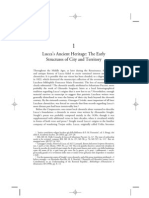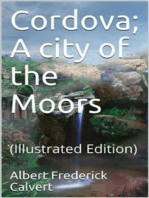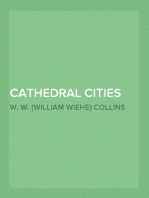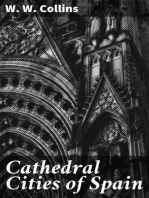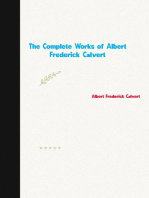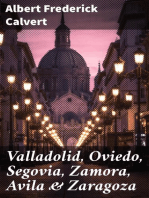Professional Documents
Culture Documents
Monumental Granada Tourism Guide
Uploaded by
dmt25Original Description:
Copyright
Available Formats
Share this document
Did you find this document useful?
Is this content inappropriate?
Report this DocumentCopyright:
Available Formats
Monumental Granada Tourism Guide
Uploaded by
dmt25Copyright:
Available Formats
1
Monumental Granada
Tourism Guide
2
In the heart of Andalusia and
In the heart of Andaluca and
linked to the Mediterranean
via the Moors Sigh pass, the
city of Granada spreads at
the feet of the Sierra Nevada
mountain range, by the ood
plain of the river Genil. The Moors nal stronghold in Spain and a
meeting place of civilisations, Granada had always acted as a brid-
ge between the cultures of West, the East and Africa.
Every year thousands of tourists come to Granada to explore its
natural delights and picturesque villages. Lorcas birthplace main-
tains a signicant Moorish heritage.
The highest mountain peaks in mainland Spain are also the destination
for many winter-sports lovers, who prefer to enjoy the peaks without
suffering the bleak winters of ski resorts at more northerly climes.
Monumental Granada
3
2
1
The Surrender of Granada by
Francisco Pradilla
Sunset at the Alhambra
New motorway to the coast
1
2
3
3
Thanks to a modern motorway network that communicates
Granada with the rest of Spain, Seville is only two hours away
and Malaga 90 minutes. While the A-92 crosses Andalusia from
East to West, the A-44 links the Costa Tropical to the south with
Jan and on to Madrid to the. Sections of the new
coastal motorway from Barcelona to Cadiz are
also now open.
The airport is 10 kilometres from the city, in
Chauchina, just off the A-92 Seville motorway.
at the feet of the Sierra Nevada
Tourism Guide
3
2
1
Costa
Tropical
Sierra
Nevada
SIERRA NEVADA
Jan
Madrid
Loja
Sevilla
Crdoba
Guadix
Almera
4
Granada, a land with thou-
sands of years of history, has a
rich artistic and cultural herit-
age passed down by the Mus-
lims and Christians.
Centuries before Islam made
Granada one of the Wests cultural benchmarks, other cultures such as the
Iberians, Romans and Visigoths left their mark throughout the province.
In the mid-15th century the magical work created by the Moors reached
its end with the sad departure of King Boabdil, only too aware of the value
and beauty he was leaving behind. A few mon-
ths before, the relentless siege of the Christian
armies of Ferdinand and Isabella camped in Santa
Fe, nally deposed Boabdil, the last Moorish king
of Granada. The tears shed by the last monarch
of Al-Andalus, as he crossed the pass now known
as the Moors Sigh, and the bitter comment by his
mother, Now you cry like a woman over what
you could not defend like a man, were instants
that would be
saved for poste-
rity to mark the
biggest turning
point in this
areas history.
From that mo-
ment on Gra-
nada became
a symbol of the
unity of Spain,
where kings and
queens lived and
even were buried.
Inheriting the enchantment
Monumental Granada
Boabdil, the last king of Granada
Boabdil leaves the Alhambra
Guadix Alcazaba
Court of the Lions, Alhambra
1
2
3
4
3
1
2
5
The entire Moorish monumental legacy was included in the heritage of the
dominant culture. Fortresses and walls, mosques and water cisterns, were
merged into churches, convents and palaces in a perfect mix of such diverse
styles as the Mudjar, Gothic, Renaissance and Baroque, to turn Granada
into a province-sized museum.
of Moorish Spain
Tourism Guide
4
2
6
Plan of
Monumental Granada
7
Granada
Tourism Guide
8
The Alhambra, which was decla-
red a UN Human Heritage Site
in 1984, is a palace city built the
Sabika hill, overlooking the river
Darro. Its name comes from the
colour of its walls (al-Hamra in
Arabic), which were made from
local reddish clay.
The Alhambras origins date
back to the 9th century, when
the Alcazaba (fortress) began to
be used as a refuge, although it
was not until the 13th century
that the frst Nasrid king, Mo-
hamed I, fxed his royal residence
there and began to build the palace complex. Suc-
cessive extensions and renovations then shaped
the monumental complex that we see today.
Moorish palaces such the Comares palace,
which contains the Court of the Myrtles and Hall
of the Ambassadors, covered with a magnifcent ceiling of
carved wood, as well as the Court of the Lions, with its
fountain that has been reproduced in a thousand picture
postcards, and halls like the Abencerrajes, Two Sister and
Monarchs.
Not only the Nasrid imprint has lasted at
the Alhambra, but we can also see the mark
left there by Emperor Charles V,
who built a Renaissance palace
that now houses the
Alhambra Museum
and Granada Mu-
seum of Fine Art.
Court of the Myrtles
Alhambra complex
Panoramic view of the Alhambra
Fountain and Court of the Lions
Hall of Two Sisters
Charles V Palace
Generalife, Court of the Water Channel
1
2
3
4
5
6
7
4
6
7
Alhambra and Generalife 1
1
2
3
Architectural
Monumental Granada
9
Just opposite the Alhambra,
the Moorish kings built the
Generalife gardens for rest
and recreation. The entrance
was via the Iron Gate, next to
the Tower of the Three Peaks,
crossing the river Chico ravine.
Inside the main feature was
water, with countless fountains,
channels and even a water
staircase that leads to the Up-
per Garden.
The Courts of the Water
Channel and Sultana refect
the Nasrid cultures special
sensitivity towards nature
and water.
Court of the Myrtles
Alhambra complex
Panoramic view of the Alhambra
Fountain and Court of the Lions
Hall of Two Sisters
Charles V Palace
Generalife, Court of the Water Channel
4
5
6
7
Heritage
1
Tourism Guide
Believed to have originally
been part of the Dar al-Bayda
palace. The Moriscos Loren-
zo El Chapiz and Hernn
Lpez El Fer built these two
buildings linked by a plaster
arch in the 16th century. The
complex manages to achieve
a perfect blend of Muslim
and Christian art, with rich
plasterwork, large marble
columns, por tico galleries,
Renaissance balustrades and
even ponds. Since 1932 it
has housed the School of
Moorish Studies.
The ablutions cour tyard
(right), together with remains
of col umns and a deep
cistern are all that remains
of the mosque on the site
of which this church was
built. Diego de Silo desig-
ned the main portal of this
Renaissance church, which
was partly destroyed by fre
during the last century and
later restored.
It houses such major works
as the Pedro Duque de Cornejo carving and a 17th-century image of Christ crucifed,
Seor de la Sangre, as well as a valuable painting of the Last Supper by Bocanegra.
The Plateresque portal, attributed to Diego de Silo,
of the building that now houses the Archaeological
Museum features beautiful reliefs with Doric columns
and a reproduction of the Alhambras Comares Tower.
The Lords of Castril gave their name to this Renais-
sance palace, with its beautiful Mudjar coffered ceiling
covering the stairway. Large balconies decorated with
pilasters give onto the exterior, while inside marble
columns support semicircular arches to create the
courtyard.
The museum houses a major archaeological collection
of pieces from the various ancient cultures that passed
through Granada.
El Salvador Church 5
Casa de Castril 7
10
Casa del Chapiz 2
Architectural
Monumental Granada
11
The Moorish Baths of the Walnut Tree
or Bauelo (in Arabic, Hamman al-Yawza)
were built by Jewish vizier Ibn Nagrela, during
the reign of the Taifa king Badis, next to the
Cad bridge. Dating from the 11th century,
the baths are among the most valuable in all
Spain, as well as the oldest surviving building
in Muslim Granada, pre-dating the Alhambra
by several centuries. Recently restored, the
baths can be visited to comme-
morate life in all
i ts f or mer
spl en-
dour at a major meeting place of
Moorish culture in Andalusia.
Original columns and caps, marble
foors and remains of paintwork on
the skirtings give into light vaulting
with star-shaped skylights for
ventilation. The layout faithfully
follows that of Roman baths,
with an entrance cour tyard
with a small pool, a vesti-
bule, cooling room, cen-
tral hall, hot room,
individual baths and
steam room.
The baths have been de-
clared an Cultural Interest Site.
El Bauelo 8
Part of a former Moorish
palace was used as the basis
for the building of this mo-
nastery between 1574 and
1592, after Queen Isabella
had opened it as a convent in
1504. The church has a single
nave, with the main chapel
raised. The font was originally
the bowl of a Moorish foun-
tain, as was the nave ceiling.
The roof, reinforced with bows
with three pairs of struts and
decorated with Plateresque
paintings, is one of the fnest
examples of Mudjar art. The main chapel features Gothic-style pyramids, mouldings and
scallops. The main altar piece is richly decorated with paintings and sculptures of saints.
The chapel houses works by such artists as Pedro de Mena and Bocanegra, as well as
the tomb of the sculptor Bernardo Francisco de Mora.
Santa Isabel la Real Monastery 10
Heritage
Tourism Guide
First built in 1506, merging the
Gothic, Renaissance and Baroque
styles. The church, holy of holies
and sacristy mark the zenith of
Andalusian and Spanish baroque.
Declared a Cultural Interest
Site, it houses a valuable co-
llection of paintings by Snchez
Cotn, as well as works by
Bocanegra and Carducho.
The single-nave church was
completed in the early 17th
century by the mason Cristbal
de Vlchez. The grey marble faade,
with two large Ionic columns, was
built in 1794 by Joaqun Hermoso.
The door dividing the choirs, by
Jos Manuel Vzquez, has marble,
tortoiseshell, silver, ebony and palo-
santo inlays. The holy of holies is
behind the main altar, with access
via a fne glazed Venetian door.
The
s a c r i s t y,
cons i der ed
to be one of
the fnest examples of
late Spanish Baroque,
has a rectangular la-
yout and barrel vault.
The skirting is Lanjarn
marble, with cabinets that
took the Carthusian J. Ma-
nuel Vzquez 34 years to complete.
It was a functioning monastery until 1836, when
the monks lands and assets were seized.
12
Sacristy
Holy of holies
Choir and main
ave
1
2
3
2
1
3
La Cartuja Monastery 14
Architectural
Monumental Granada
13
In the Albaicn quarter there are
still many remains of the fortifcations
that once surrounded Granada, many
of them from the Zirid period in the
11th century. They include towers and
entrances to the city, such as the Mo-
naita and Pesas gates and Postigo de
San Lorenzo. In the 14th century the
wall was built to defend the districts of
San Cristbal Hill, the Albaicn and the
Albayda, running from the Guadix Gate, over San Miguel Alto, to the Fajalauza Gate
and Postigo de San Lorenzo down to the Elvira Gate. The Postigo de San Lorenzo
or Albaicn Gate was rediscovered in 1983.
Albaicn walls 12
Currently housing the univer-
sity administration offces, this
major building was founded by
Ferdinand and Isabella in 1504
to treat the wounded from the
War of Granada.
It was built according to a late-Gothic design by
Enrique Egas, although Charles V had it fnished in
the Renaissance style. The entrance, with sculptures
by Alonso de Mena and four Plateresque windows,
was not completed until the mid-17th century.
Hospital Real 13
Built in the 15th century on the site of a
former Nasrid palace, it was the last home of
King Boabdils mother, Aixa, after whom it is
named (Dar al-Horra means house of the
honest lady).
It is built on two foors, with a tower on the
north side. The interior space is laid out with a
courtyard and passages between rooms with
horseshoe vaulting. The rafters and mullioned
windows are particularly fne, as are the other
Arabic inscriptions in the interior.
Of particular note is the ceiling decoration,
with geometrical fgures and horseshoe vaul-
ting that gives on to an observation point with
splendid views over the Albaicn.
Dar al-Horra Palace 11
1
Heritage
Tourism Guide
The church, declared a basilica by Pope
Benedict XV, is located next to the hospital
(1552) and was built between 1737 and
1759. The layout is a Latin cross: a nave with
side chapels (two on each side), transept,
main chapel and choir. The interior is richly
decorated with gold, silver, altar pieces, wall
paintings, cornucopias and windows, as well as
fne chapel altar pieces and transepts, frescoes
by Diego Snchez Sarabia and the main altar
piece, which houses the remains of the saint
to which the church is dedicated.
The portal, fanked by two high bell towers,
forms a harmonious unit with the hospital and
dome of the basilica.
Although construction began
during the reign of Ferdinand
and Isabella, it was not completed
until 1547, under the direction of
Diego de Silo. It has fne vaulting
with decorated caissons and
an elegant cloister by the main
gallery, for which stone from the
Moorish Elvira Gate was reused.
In one of the cloisters, where
Empress Isabella, the wife of
Charles V, lived, we can see fne
Mudjar and Gothic decorative
elements. The Great Captain Is
buried here. The monastery was
originally richly decorated, but it
was sacked by Napoleons troops
and later used as a barracks. It has recently been restored under partnership arrange-
ment between the University of Granada and Order of St. Hieronymus.
Formerly the Quran School
founded by Yusuf I, it was conver-
ted into a cabildo by the Christians,
where the nobles who governed
the city met.
A horseshoe arch gives onto
the elegant mihrab, the only part
of the original Moorish building
to have survived. The interior is
richly decorated in the Alhambra
style. A Baroque palace was sub-
sequently built around a courtyard
with arched galleries supported by
Tuscan columns. The facade is Baroque, with a stone portal and timber and wrought
iron windows and balconies.
San Jernimo Monastery 16
Madrassa Palace 20
14
San Juan de Dios Basilica 15
Architectural
Monumental Granada
15
Declared both a Natio-
nal Monument and Cultu-
ral Interest Site, Granada
Cathedral is considered to
be the frst Renaissance
church in Spain and one
of the best examples of
the style. Ferdinand and
Isabella had it built in
1492, and it was originally
designed to follow the
Gothic model of Toledo
Cathedral. In 1528 Diego de Silo took over the project
and designed a new layout on the Spanish Renaissance
model. The works were fnally completed nearly 200
years later, in 1704. Of the two towers designed by Silo
only one was partly built, at a height of 57 metres rather
than the 81 metres originally planned. The main faade
is a Baroque masterpiece by Alonso Cano en 1667.
Next to the Cathedral is the Royal Chapel, built
to house the tombs of Ferdinand and Isabella. The
Plateresque faade, by Juan Garca de Prada, faces the
former market. It was built in the Gothic style in 1506
and dedicated to St John the Baptist and St John the
Evangelist. It was completed in 1517 during the reign of
Charles V, who also transferred the tombs of his parents,
Joanna the Mad and Philip the Fair, here. The chapel is a
key example of famboyant Gothic during the Renaissance period. The interior includes
a splendid Plateresque
grille by Bar tolom de
Jan, a Gothic altar piece
dating from 1522, and
the royal tombs carved
from Carrara marble. The
crypt beneath houses the
lead coffns of Ferdinand,
Isabella, Joanna, Philip and
Prince Michael.
Cathedral, interior
Royal Chapel grille
Cathedral, main facade
1
2
3
1
2
3
Cathedral and Royal Chapel 17
Heritage
Tourism Guide
The only remaining alhn-
diga (public wheat market)
of the three that Granada is
reported to have once had.
It was built in the 14th cen-
tury as an inn for merchants.
The upper foor was used
for accommodation and the
lower foor as stables and
storage areas. The faade
has a horseshoe arch with
stalactite-type plasterwork
and epigraphic motifs. It has
been used for several different purposes over the course of its history, from a theatre
and then a lodging house in the 16th century to a coal store in the 18th.
In 1545 a brotherhood was
founded in honour of the So-
rrow of Our Lady, to which Don
Juan of Austria and Ferdinand
VI belonged. In 1567 Philip II
donated land for a hospital to be
built, next to which this Baroque
church was built and opened in
the 17th century.
The facade is fanked by two bell towers
fnished with glazed tiles. The interior houses a
fne altar piece and a Virgins chamber decorated
by such artists as Juan de Mena.
This old rbita (a monastery
where which pious Muslims with-
drew to meditate) was built in 1218
and is of historical importance as the
site where Boabdil delivered the keys of
Granada to Ferdinand and Isabella in
1492. Shortly afterwards it began to
be reused as a Christian church
dedicated to St Fabian and St
Sebastian.
The square layout is covered by a hemispherical brick dome. It was
declared a National Monument in 1933. The exterior is very simple, with
a horseshoe arch framed with a brick alfz as an aesthetic concession.
The original interior decoration has been lost as a result of successive
restoration projects.
16
Corral del Carbn 21
San Sebastin Hermitage 30
Church of Nuestra Seora de las Angustias 29
Architectural
Monumental Granada
17
Founded in the 16th century,
this Gothic church is par t of
the Monastery of Santa Cruz la
Real, where the Spanish Inquisi-
tion held its trials. The interior
of the church is structured on
a Latin-cross layout, with fve
chapels on each side. Although
the decoration shows a Baroque
infuence, the vaulting and arches
are in the Gothic style and the
columns, windows, cornices and
main doorway are Romanesque.
The entrance is presided over by a stone portal with three semi-circular arches
supported by Doric columns.
Traditionally believed to have been built
over the dungeons where Christian
captives were held in Nasrid times.
After the city was conquered by
Ferdinand and Isabella it was
us ed as a Carmelite con-
vent, whe- re St John of
the Cross was the prior for
several years. Its current
appearance dates
back to the 19th
cent ur y, showi ng
Orientalist trends that
were fashionable at the
time. The gardens are an
attractive mixture of French
and English models combined with the
aesthetics of Moorish garden design.
Church of Santo Domingo 22
Carmen de los Mrtires 27
Alczar Genil 22
A 13th-century Almohad palace, built
during the reign of the caliph al-Muntasir
as a place for the court to relax, with
orchards and gardens and a large pond
where naval battles were recreated.
Aixa, the mother of Boabdil (the
last Nasrid king) lived here until
the city was conquered by the
Christians. All that remains of
the original building is a square
space decorated with stucco
and tiling similar to that found
in the Alhambra. The room is
covered with artesonado de
laceras and stalactite friezing.
Twin arches give onto alcoves on each side.
Heritage
Tourism Guide
Accordi ng to
c ont empor ar y
chronicles, after
the surrender of
Granada to the
Christians, many
gipsies who had
a c c o mp a n i e d
Ferdi nand and
Isabellas troops
as metalworkers
settl ed i n thi s
quarter. Over the
centuries, the ar-
tistic expression they carried in their genes became mixed with those of the Moriscos
to give rise to the zambras. The Sacromonte Caves Museum shows the history and
evolution of the cave-dwellers lives and customs. A cave house has been restored
with traditional furniture and utensils.
The magic of the whitewashed houses and caves, surrounded by prickly pears and
decorated with carnations and jasmine, form a pretty landscape with the Alhambra
(1) or Sierra Nevada beyond. Sacromonte Abbey, which was founded in the 17th
century by Don Pedro de Castro, houses major works by such artists as Alonso
Cano, Bocanegra, Raxis and Snchez Cotn.
The Albaicn is the part of Granada that best
refects the citys Moorish cultural heritage. The
carmen, or house with walled orchard or garden,
is possibly of Moorish origin and is the most
representative type of housing in the quarter,
facing the Alhambra. The narrow streets of the
quarter, a UN Human Heritage Site, with their
old water cisterns and lush gardens, are the result
of the Muslim population moving out of other
parts of the city after the Christian conquest.
Enjoy beautiful sunsets over the Alhambra
from the observation points of San Nicols and
San Cristbal, with the snowy backdrop of the
Sierra Nevada.
Albaicn 6
18
Sacromonte 3
Architectural
Monumental Granada
This barrio used to be the Jewish
quarter during the Moorish period,
known as Garnata al-Yahud.
The old Fajjarn, Neched, Potters
and Millers gates have not survived,
but the higher parts of the area
still conserve some of the original
typical Moorish layout of winding
narrow streets.
The Mauror hillside running down
from the Torres Bermejas is known
as Antequeruela, since it was where
the inhabitants of the town of Ante-
quera were rehoused in 1410.
Realejo
19
In the late 19th century a
fre destroyed the old bazaar,
which was later rebuilt. The
current version is an accurate
recreation of the old market
next to Ofcios and Zacatn
streets. The jeweller y and
ornament shops are full of
samples of traditional cera-
mics, silverware, basketry and
taracea marquetry.
The Alcaicera recreates the
retail activity of Moorish Gra-
nada, which reached its peak
splendour during the fnal Nasrid period. The city was particularly well known for the
quality of its main speciality: silk.
These bazaars were located in city centres. They included accommodation and were
ftted with doors at the ends that were closed at night to prevent theft.
Alcaicera 18
This concert hall is the venue
for regular performances by the
Orquesta Ciudad de Granada.
A full programme of concerts
and exhibitions make it an ideal
meeting place for music and
art lovers.
The centre complex also has
an archive, also named after the
great composer, as well as his
museum house.
Centro Cultural Manuel de Falla 26
23
Heritage
Tourism Guide
A stroll through Moorish Granada:
Monumental Granada
20
Plaza Nueva, flanked by the Real
Chancillera to the left and the church
of Santa Ana to the right, is the starting
point for an intense visit to the heart of
old Zirid and Nasrid Granada, following
the course of the river Darro along a
picturesque street that eventually opens
out onto the Paseo de los Tristes.
Soon we see the ruins of the Cad
bridge, which once linked the Albaicn (6)
(p. 20) to the Alhambra (1) (p. 10). Worth a look on the way are the Bauelo
(8) (p. 13), the 11th-century Nogal Moorish baths and the Plateresque Casa de
Castril (7) (p. 12), as well as the convent of Santa Catalina de Zafra and church
of San Pedro y San Pablo.
A gazebo-covered walk flled with terrace restaurants announces our arrival
at the Paseo de los Tristes or Boulevard of the Sad Ones, so called because
it lies on the old route up to the citys cemetery. In the 17th century the Casa
de las Chirimas was built here, formerly housing the musicians that performed
in the square.
5
4
Carrera del Darro
Albaicn alleyway
The Albaicn from the Alhambra
Paseo de los Tristes
Mirador de San Cristbal from
the Dar al-Horra Palace
Aljibe del Rey
Sunset at the Alhambra,
Mirador de San Nicols
1
2
3
4
5
6
7
1 2
3
The Albaicn
Tourism Guide
21
Turning left, a steep hill
takes us up to the Casa del
Chapiz (2) (p. 12). Opposi-
te, the Carmen de la Victo-
ria offers fne views of the
Alhambra. Continuing up
the hill, we come to other
interesting buildings, such as
the church of El Salvador
(5) (p. 12) and convent of
Las Tomasas, as well as the
frst of the Albaicns 23
Moorish water cisterns.
When we arrive in Plaza
Larga, the hustle and bustle gives us an idea of what the Moorish medina must
have been like. Here you can see the remains of the walls (12) (p. 15) of the
Oadina fortress, whose two gates, the Arco de las Pesas and Puerta de Monaita,
are the oldest in the city. Also nearby is the Mirador de San Nicols, where the
citys most beautiful sunsets can be enjoyed from the square, with the Alhambra
opposite and the San Nicols church behind.
History-laden stone walls lead to the Dar al-Horra Palace (11) (p. 15). From
a beautiful window above there are marvellous views of the Mirador de San
Cristbal and long stretches of old walls (12) (p. 15). Nearby are the Monastery
of Santa Isabel la Real (10) (p. 13) and
the church and square of San Miguel Bajo.
Going down Calderera Nueva and Vieja
streets we return towards the Elvira Arch,
which linked the Albaicn to the medina.
5
4
7
6
The city centre:
Monumental Granada
22
Gran Va de Coln, with
the Albaicn to the right
(6) (p. 20-22), ends at
the gardens of the Triunfo
fountain, with the Hospital
Real looming above (13)
(p. 15). Behind, Calle Real
Cartuja leads up to the
monastery of La Cartuja
(14) (p. 14), a jewel of the
Baroque.
Back on Avenida de la
Constitucin, among a
maze of narrow streets
and squares we fi nd
beautiful buildings as the
basilica of San Juan de
Dios (15) (p. 16), next to
the old Duquesa quarter,
named after the wife of
the Great Captain, who
fnanced the building of
the monaster y of San
Jernimo (16) (p. 16) to
provide a suitable tomb
for her celebrated hus-
band.
A palace legend gave two special places in Granada their names: Trinidad and
Los Lobos squares. In the 17th century the Jesuits wanted to compensate for the
labyrinthine layout of the Moorish city with a more Christian urban plan, building
the College of Santos Justo y Pastor next to the Plaza de la Universidad, where
the Law Faculty is located.
1
2
3 4
the Christian heritage
Tourism Guide
23
Around San Jernimo are several tiny, atmosphe-
ric squares surrounding the Cathedral (17) (p. 17),
such as the Plaza de la Romanilla and Pescadera.
After the majesty of the Cathedral, the former
Lonja leads to the Royal Chapel (17) (p. 17), the
site chosen by Ferdinand and Isabella as their
fnal resting place giving us an idea of just how
important Granada was in the design of the new
Christian kingdom. The adjoining Madrassa Palace
(20) (p. 16) and Archbishops Palace are worth a
visit before entering the maze of the shops of the
Alcaicera (18) (p. 21), which faithfully recreates
the bustling silk market of
Nasrid times.
The nearby Plaza de
la Bib Rambla is a major
square in the city, flled
with bar terraces and
fower stalls. In the past
it was a walled esplanade.
Thi s whol e area i s
the heart of the city of
Granadas shopping dis-
trict and includes such
well-known places as the
Carrera del Genil, Acera
del Darro, Puerta Real and Plaza Nueva. Plaza de
Isabel la Catlica, with a monument to Queen
Isabella and her subject Christopher Columbus
is only a few minutes walk away from the Casa
de los Tiros, Corral del Carbn (21) (p. 18) and
Abrantes Palace.
7
6
5
8
Triunfo fountain
Chancillera palace
Pl. de la Romanilla and the Cathedral
Monument to Queen Isabella
Casa de los Tiros
Plaza de la Bib-Rambla
Archbishops Palace
Santa Ana church
1
2
3
4
5
6
7
8
2
Because of the steepness of the
hills in the Realejo quar ter, it is
probably best to star t your visit
from the top, before working our
way downwards, beginning with the
Carmen de los Mrtires (27) (p.
19) and, to the right, the Manuel
de Falla concert hall and museum
(25), where the Cadiz-born musi-
cian lived. The neighbourhood has
two other sites of particular interest
for culture lovers: the Rodrguez
Acosta Foundation (24) and G-
mez Moreno Institute.
The imposing Torres Bermejas
stand out among beautiful crmenes
and whitewashed courtyards leading
down to the la Antequeruela quar-
ter. As the land levels out, we see
the washing area of the Puerta del Sol square, with the heart of the Realejo now
close by: the Campo del Prncipe, where Prince John celebrated his wedding.
This large square has many cafs, restaurants and tapas bars to attract visitors,
and it is an ideal place for a rest before continuing on to the quarters most
signifcant religious buildings: the convent of the Comendadoras de Santiago,
convent of Santa Catalina, church of Santo Domingo (22) (p. 19) and church
of San Cecilio, with the Cristo de los Favores statue opposite.
Old galleried lodging houses, which have now been restored, blend in with
urban mansion houses such as the Casa de los Tiros. Finally, if you cross the
river Genil, you can admire the hermitage of San Sebastin (30) (p. 18), Genil
Alczar (31) (p. 19), Science Park (32) and Andalusian Memory Museum (33).
2
The Realejo: a cultural melting-pot
Monumental Granada
24
1
Granadas Science Park (32) brings science closer to visitors with interactive
displays and permanent exhibitions on various topics: health and life in the
Journey to the Human Body; accident-risk awareness in Health and Safety Culture;
Biosphere tells the story life on Earth, with its geological changes, the appearance
of life, DNA and such curiosities as a surveillance camera watching the movements
of piranhas and a real-time world population counter. Perception allows visitors to
play with light and sound and discover how our brain tricks us when perceiving
certain phenomena. Eureka reveals the secrets of physics experiments; Al-Andalus
and Science explains the groundbreaking scientifc brilliance of the Moors; REMPA
opens up the Andalusian Network of Protected Natural Spaces; and Explora has
been specially designed for young children to play with science.
Other exhibition spaces explore our knowledge of our surroundings: Kugelbahn
13, Botanical Routes, Observation Tower, Tropical Butterfy, Birds of Prey in Flight,
Museum Pieces, Black Hole Module, Averroes Hall, Planetarium, Astronomy Gar-
den and Ecological Roofs. In addition, many temporary exhibitions are organised,
such as: Fossil Art, Symbols of the Sierra Nevada, Automata, Stem Cells, Museum
Animals, 150 Years of Ecology in Spain, etc.
The Caja GRANADA Memory of Andalusia Museum (33) invites you to disco-
ver who the Andalusians are, who they were and who they will be in the future.
The purpose of this permanent exhibition is to show the culture and history
of Andalusia through the facilities at the new Cultural Centre. It is intended for
everyone: families, students, associations, old people, those interested in history,
the university and research community and, of course, people who are visiting
Granada and are interested in Andalusian identity presented and explained in
an accurate, attractive way.
3
4
Science and history
2
Tourism Guide
25
1
Campo del Prncipe
Torres Bermejas
Memory of Andalusia Museum
Panoramic view of the
Science Park
1
2
3
4
1
26
Events such as the International Music and Dance Festival, which is held in
some of the most beautiful corners of the city, the Tango and Jazz festivals and
the Young Filmmakers Festival have become essential dates in many peoples
cultural diaries.
But cultural events are not limited to the city itself, but organised throughout
the surrounding area. Not to mention famenco, of course, one of Granadas
best-known identifying features, which can be enjoyed in the Sacromonte caves,
where popular gypsy zambra dance shows are put on.
Besides its enormously rich heritage, the city of the Alhambra is home to a large
number of museums on diverse topics: the Museum of Fine Art and the Alhambra
Museum, both housed in the Charles V Palace, the Archaeological Museum, the
Museum of Ferdinand and Isabella..., the Science Park, an interactive museum
and planetarium where adults and
children can discover the fascinating
world of science and the Universe,
and the recently opened Andalusian
Memory Museum.
The area where Federico Garca
Lorca was born has many stages in
nearby towns where cultural events
are held.
At the Manuel de Falla Concert
hall, the Orquesta Ciudad de Gra-
nada, one of the leading orchestras
in Spain, has many faithful followers
who dont miss a single performance.
Music and Dance
Festival
Museum of Fine Art
1
2
2
Cultural
Monumental Granada
27
MUSEUMS
Granada
CARMEN MUSEO MAX MOREAU
Carmen de los Geranios. Nuevo San Nicols, 12 % 958293310
CENtRO EUROPEO DE lAS MUJERES-CASA MARiANA PiNEDA
guila, 19 % 958262961-262838
www.marianapineda.com
CASA-MUSEO DE NgEl BARRiOS Real de la Alhambra
% 958027900
CASA-MUSEO FEDERiCO gARCA lORCA (Huerta de San Vicente)
Virgen Blanca, s/n % 958258466
www.huertadesanvicente.com
CASA-MUSEO MANUEl DE FAllA Antequeruela Alta, 11 % 958222188
www.museomanueldefalla.com
CENtRO DE ARtE CONtEMPORNEO Jos Guerrero Ofcios, 8
% 958225185 www.centroguerrero.org
MONAStERiO MUSEO DE lA CONCEPCiN
Placeta de la Concepcin, 2 % 958225368
MUSEO ARqUEOlgiCO y EtNOlgiCO
Casa de Castril. Carrera del Darro, 41 % 958575408
MUSEO CASA DE lOS tiROS Pavaneras, 19 % 958575466
MUSEO CUEvAS DEl SACROMONtE
Barranco de los Negros, s/n % 958215120
www.sacromontegranada.com
MUSEO DE BEllAS ARtES Palacio de Carlos V % 958575450
MUSEO DE lA AlHAMBRA Palacio de Carlos V % 958027900
MUSEO DE lA CAtEDRAl Gran Va, 4 % 958222959
MUSEO DE lA MEMORiA DE ANDAlUCA Avda. de la Ciencia, 2
% 958222257 www.cajagranada.es
MUSEO EtNOlgiCO DE lA MUJER gitANA Cno. del Sacromonte, 107
La Chumbera % 958161278 www.mujeresromi.org
MUSEO gMEz-MORENO-FUNDACiN RODRgUEz ACOStA
Callejn Nio del Royo, 8 % 958222797
www.fundacionrodriguezacosta.com
MUSEO REyES CAtliCOS Capilla Real. Ofcios, 3 % 958229239
www.capillarealgranada.com
MUSEO DEl SACROMONtE Abada del Sacromonte, 1 % 958221445
MUSEO DE SAN JUAN DE DiOS Casa de los Pisa Convalecencia, I
% 958222144 / www.sanjuandedios-oh.es
PARqUE DE lAS CiENCiAS Avda. de la Ciencia, s/n
% 958131900 / www.parqueciencias.com
Atarfe
MUSEO DE CiENCiAS NAtURAlES Ermita de los Tres Juanes
Parque de Sierra Elvira % 958439008
MUSEO El ARCA DE lOS tiEMPOS Parque Ramn Gardn % 958439008
Belicena
CENtRO DE iNtERPREtACiN DE lA vEgA DE gRANADA
Vial de la Vega, s/n. % 958432051
Fuente Vaqueros
MUSEO CASA NAtAl FEDERiCO gARCA lORCA
Poeta Federico Garca Lorca, 4 % 958516453 www.patronatogarcialorca.org
Valderrubio
CASA FEDERiCO gARCA lORCA Iglesias, 20 % 958454466
www.museolorcavalderrubio.com
Vznar
El MOliNO DE lA vENtA Retiro, s/n % 958543304
THEATRES
Granada
tEAtRO AlHAMBRA Molinos, 56 % y Fax: 958028000 Fax: 958226462
tEAtRO iSABEl lA CAtliCA Acera del Casino, s/n
% 958222907. Fax: 958229344
tEAtRO iSiDORO MiqUEz Avda. de la Ciencia, 2
% 958244978
tEAtRO JOS tAMAyO Ctra. de Mlaga, 100 (Antiguo Mercachana)
% 958028000
tEAtRO MUNiCiPAl zAiDN
Centro Cvico, Pintor Manuel Maldonado % 958130985
Alfacar
tEAtRO MUNiCiPAl DE AlFACAR Avda. Fco. Garca Lorca, s/n % 958543582
Armilla
tEAtRO MUNiCiPAl DE ARMillA Nardos, s/n % 958573141
Fuente Vaqueros
tEAtRO FEDERiCO gARCA lORCA Manuel de Falla, 2 % 958516860
CONCERT HALLS
Granada
AUDitORiO MANUEl DE FAllA Paseo de los Mrtires, s/n % 958222188
Fax: 958228289 / manueldefalla@granada.net www.manueldefalla.org
Atarfe
CENtRO CUltURAl MEDiNA ElviRA
Avda. Diputacin % 958436011-958438418
TOURI ST SEASON TI CKET
The card that covers all the citys major monu-
ments and bus network
% Reservations: 902 100 095
% From outside Spain: 915 962 693
www.cajagranada.es / www.turgranada.es
Granada
Tourism Guide
28
Many satellite towns and vi-
llages lie around Granada itself,
with historical links to the city
and sharing in its rich heritage.
A tour of Granadas fer ti l e
Vega (the flood plain of the
river Genil) takes us to small
towns with a rich history, such
as Santa Fe, founded in 1491 as
the headquar ters of Fernando
and Isabellas army, to prepare
the final assault on the Nasrid
kingdom. The four gates of the
ol d ci tadel are sti l l i n pl ace:
Granada, Loja, Seville and Jan.
The shades of green of strips
of popl ar s and or-
chards characterise the
surroundings of such
villages as Chauchina,
Fuente Vaqueros and
Cijuela, where accor-
ding to legend Alha-
mar, the founder of the
kingdom of Granada,
l ed the to recover y
of i ts i rri gati on sys-
tems and channels. The
Vega de Granada
visitors centre in Belicena is housed in a former tobacco-dr ying shed
built in 1953.
4
5
1
2
3
Around
Monumental Granada
29
The r i ch archaeol ogi cal remai ns
dating from prehistoric times to the
Musl i m peri od bri ng together such
villages as Vegas del Genil, Cllar Vega
and Churriana de la Vega, with remains
of an old construction in Plaza de la
Consti tuci n, and where, accordi ng
to tradition, the surrender of Boabdil
was arranged with Ferdinand and Isabellas emissaries. A Roman villa, with
remains of baths and cr ypts, announces our arrival in Las Gabias.
Sixteen 16 kilometres to the south-west of the city lies La Malah, a name
derived from the Arabic al-Malaha, which means salt farm. The salt mi-
ned here was delivered by
Ferdinand and Isabella to
El Zagal, and the medicinal
waters of the spa here are
a major tourist attraction.
One of the most specta-
cular views of Granada and
the Vega can be enjoyed
from the promontor y on
whi ch Otura was bui l t.
Not far from the village
is the place known as the
Moors Si gh, where the
det hroned ki ng Boabdi l
wept as he said his last farewell to his beloved
kingdom. Alhendn and Armilla, in an area that
was first settled in ancient times, conclude our
route through the Granadas fer tile plain, with
sights including the 16th-centur y church of Nues-
tra Seora de la Concepcin and the Cor tijo de
los Huer tos archaeological site.
Santa Fe
Chauchina
La Malah
Las Gabias
The house in Fuente Vaqueros
where Lorca was born
1
2
3
4
5
4
5
Granada
1
2
3
Tourism Guide
30
Near the banks of the river Genil are such towns as Maracena and
Albolote, with a rich ar tistic heritage that includes the church of La En-
carnacin del Hijo de Dios y Anunciacin de Nuestra Seora.
The remains found in Atarfe bring visitors closer to the former Roman
settlement of Iliberis. The medicinal proper ties of the sulphur-rich waters
of the Sierra Elvira underground springs have been appreciated since
ancient times.
Testimony of the historical impor tance of the site of todays town of Pinos
Puente is provided by the remains of the Roman town of Illurco (Cerro
de los Prncipes), the Ibero-Roman settlements at Cerro de las Agujetas
and Cerro de los Infantesm and Cor tijo de Darangoleja, a late Roman villa.
Around Cubi l l as reser voi r
are the vi l l ages of Peligros
and Cal i casas, as wel l as
Gevjar, whose manor house
was totally destroyed by an
earthquake i n 1755, whi l e
another quake, at Christmas
time in 1884, known as the
Andalusian Ear thquake An-
daluca, forced the village to
relocate to its current site.
Pulianas and Jun, which are
now suburbs of the city, have
a rich tradition in terracotta
and potter y.
In the beautiful landscapes
of Sierra de Hutor Nature
Park, where ravines alternate
wi th cal ares and mountai n
1
2
Monumental Granada
Around
streams, nestle a cluster of villages with special charm, despite still being
close to the city.
In Cogollos Vega the 17th centur y parish church houses an image of
the Pursima attributed to Alonso Cano, as well as remains of Moorish
baths. In Nvar, originally a Moorish watchtower, the Plaza de la Iglesia is
wor th a visit, as is the so-called Balcony of Nvar (Calle de los Pretiles),
where the truce between Abenamar and John II was signed. The Pea de
Bar tolo site is also of great archaeological value.
As par t of its architectural heritage Vznar conser ves El Cuzco Palace,
built in 1800, where the Granada-born poet and dramatist Federico Garca
Lorca was held prisoner before he was shot in 1936.
The name of Hutor Santilln brings together both Moorish and Chris-
tian traditions. Hutor
is probably derived from
the Arabic wadi (river),
whi l e Sant i l l n comes
from the Christian con-
quest, referri ng to the
local devotion to St Illn.
Older documentar y re-
ferences al so menti on
Beas de Granada on
the Roman road to Acci
(Guadix), hence the name
Veas (road).
31
3
4
Archaeological site in Atarfe
Gevjar
Nvar
Cuzco Palace, Vznar
1
2
3
4
1
Tourism Guide
Granada
32
When the Moors arrived in the province of Granada they for tified the
towns and built an impressive network of for tresses and border castles.
Granadas Costa Tropical reached its peak splendour during this period,
with such defensive structures as San Miguel Castle, in Almucar, which
was later rebuilt by the Christians, Salobrea Castle, with its fine Homage
Tower and Castell de Ferro.
The Moorish castle at Alhama de
Granada, remai ns of l l ora Castl e,
the Loj a for tress compl ex, whi ch
dates back to the Omeya period, and
Mocln and Montefro castles, both of
which are National Monuments, are
the fi nest exampl es
of the Moorish past
i n western Granada
province.
In Granadas hi gh
plain to the East
the Baza and Huscar
areas we can still
see Baza Al cazaba,
the remains of Castril
Castle, and, in Orce,
the Alcazaba de las
Siete Torres and Sa-
lar and Umbra wat-
chtowers, en Orce.
In the Guadix and
El Marquesado area,
of par ticular note are
the Alcazaba and the
10th- and 11th-cen-
tur y walls in Guadix.
A province
Monumental Granada
Salobrea
Almucar
Loja
Montefro. Pea de los Gitanos
Alhama de Granada
1
2
3
4
5
2
3
1
33
Granada provinces rich heritage gives us an idea of the historical and
cultural impor tance of this last holdout of Muslim Spain. We present here
only the briefest of outlines of the provinces monuments and archaeo-
logical sites, since the Provincial Tourism Depar tment has published a set
of specific guides for each area of the province where more detailed
information can be found.
For centuries Granadas Costa Tropical was the por t of entr y for cultu-
res and civilisations who chose this territor y to settle and develop their
traditions and ways of life. Major Neolithic remains have been conser ved
at the Cave of the Bats in Albuol.
The Phoenicians and Romans also arrived on these shores, developing a
prosperous economy largely based on trade and the exchange of goods
an economic boom that would be reflected in the structures from
the period that have sur vived in Almucar: the Phoenician la necropolis
of Puente de Noy, the Punic necropolis of Laurita, a Roman aqueduct, a
Roman salt-fish factor y, the Cave of the Seven Palaces and funeral niches,
also dating from Roman times.
Western Granada province is rich in archaeological sites, including the
Pea de los Gitanos in Montefro, with remains of megalithic burial remains,
and the Sierra Mar tilla sites and dolmens in Loja.
As this area became the border countr y between the Nasrid kingdom of
Granada and the Christian lands, many castles and for tresses were built. In
Alhama de Granada Moorish baths and hot springs have been conser ved
i nsi de the towns spa
facilities.
The areas rel i gi ous
architectural splendour
began with the Chris-
tian conquest, with such
works as Gothic church
of La Encarnacin and
El Carmen Church i n
Alhama de Granada, the
5
4
of monuments
Tourism Guide
Salobrea
Almucar
Loja
Montefro. Pea de los Gitanos
Alhama de Granada
2
3
1
34
Renaissance church of San Gabriel
i n Loj a, as wel l as the Neo-
classical church of La Encarnacin,
redolent of Agrippas Pantheon in
Rome, and the church of the Villa
de Montefro.
The famous Lady of Baza statue
was found in Baza, a town on the
high plain of Baza and Huscar in
Granada province, and just one
of many archaeological treasures
found. In Baza you can visit the
Hoya de Baza archaeological com-
plex at the Cerro del Santuario
de los Tres Pagos, or the Ibero-
Roman town of Basti. Orce has
the paleontological complex of
Venta Micena and Barranco del
Paso, whi l e i n Galera there i s
the Iberian necropolis of Ttugi,
where the Lady of Galera was
discovered.
The nor thernmost towns in the
area have a noble past, as eviden-
ced by the many mansion houses
and churches that were built as
symbols of the splendour of the
Christian conquest: the Colegiata
Concatedral de la Encarnacin, in
Baza, the Colegiata de Santa Mara
la Mayor, built by Diego de Silo,
in Huscar, and the Segura and
Belmonte Palaces, both in Orce.
A province
Monumental Granada
Montefro
Moorish baths, Baza
Dolmen in Gorafe
Encarnacin College, Baza
College interior, Huscar
Orce castle
La Calahorra castle
Guadix cathedral
1
2
3
4
5
6
7
8
3
2
1
4
35
The Integrated Megalithic Theme Park in
Gorafe, with the largest concentrations of
dolmens in Andalusia, is a fine example of
the archaeological richness of the Guadix
and El Marquesado area. It is fur ther com-
plemented by the remains of the Cueva
Hor, in Darro, the Neolithic and Bronze
Age sites at Solana de Zamborino, in Fo-
nelas, the Cueva del Agua, with interesting
cave paintings, in Iznalloz, the Cueva de las
Ventanas in Par, and the dolmen area
in El Mencal.
The town of Guadix is a monument in
its own right, with its outstanding cathedral,
combi ni ng Gothi c,
Rena i s s a nc e a nd
Baroque styles, and
the church of San-
tiago, with its Mud-
jar tower and por tal
by Diego de Silo.
Also wor th a visit
is the Renaissance
castle-palace of La
Calahorra, with its
por ti co cour tyard,
which has been de-
cl ared a Nati onal
Historical and Ar tis-
tic Monument
of monuments
Tourism Guide
5
6
7
8
7
3
2
1
4
You might also like
- Best Sites in Granada - SpainDocument25 pagesBest Sites in Granada - SpainDreamsAvenue.comNo ratings yet
- Berlitz Pocket Guide Nice, Cannes & Monte Carlo (Travel Guide eBook)From EverandBerlitz Pocket Guide Nice, Cannes & Monte Carlo (Travel Guide eBook)No ratings yet
- Catania GuideDocument13 pagesCatania GuideTheodwra Tsanaka Carlos AreaNo ratings yet
- Istanbul Guides YouDocument27 pagesIstanbul Guides YouahmedalaouichrifiNo ratings yet
- Bansko in Your PocketDocument40 pagesBansko in Your PocketIn Your Pocket City Guides100% (17)
- Jordan DetailsDocument60 pagesJordan Detailsebin_thankachan1988No ratings yet
- Madrid Guide Internships in MadridDocument13 pagesMadrid Guide Internships in MadridYesEuropaNo ratings yet
- Spanish Cultural Project on Gaudi's Iconic ArchitectureDocument10 pagesSpanish Cultural Project on Gaudi's Iconic ArchitectureLauraNo ratings yet
- Egypt 9 Cairo Egyptian Museum v1 m56577569830522946Document88 pagesEgypt 9 Cairo Egyptian Museum v1 m56577569830522946文者美善治者理No ratings yet
- ParisDocument52 pagesParisNashit_Khan_62460% (1)
- Islamic CairoDocument38 pagesIslamic Cairoapi-3747360No ratings yet
- (Martin Dunford) The Rough Guides' Rome DirectionsDocument231 pages(Martin Dunford) The Rough Guides' Rome Directionssoltero2No ratings yet
- Mauritius Reunion Seychelles ContentsDocument40 pagesMauritius Reunion Seychelles Contentsfusoteo100% (3)
- La - Rioja.lonely Planet - Spain Basque-Country Navarra La RiojaDocument25 pagesLa - Rioja.lonely Planet - Spain Basque-Country Navarra La RiojacaramierdaNo ratings yet
- Crossbill+Guides Loire+ValleyDocument50 pagesCrossbill+Guides Loire+ValleywadekevNo ratings yet
- GB Guide PratiqueDocument88 pagesGB Guide Pratiquechryssy033388No ratings yet
- Morocco - S. L. BensusanDocument1,090 pagesMorocco - S. L. BensusanHolly Robles0% (1)
- Discover PragueDocument116 pagesDiscover PragueAngela OngNo ratings yet
- Madeira Car Tours and WalksDocument148 pagesMadeira Car Tours and WalksSosonanaNo ratings yet
- Wanderlust - Cordoba City Guide March 11Document2 pagesWanderlust - Cordoba City Guide March 11Sam SheadNo ratings yet
- Lucca's Ancient Heritage. The Early Structures of City and TerritoryDocument26 pagesLucca's Ancient Heritage. The Early Structures of City and TerritoryGerardo LarghiNo ratings yet
- Brochure Morocco Geo TravelDocument2 pagesBrochure Morocco Geo TravelAziz SegaouiNo ratings yet
- Venice Simplon Orient ExpressDocument15 pagesVenice Simplon Orient ExpressLakshmi DeviNo ratings yet
- Belgium & Luxembourg - BrusselsDocument51 pagesBelgium & Luxembourg - BrusselsFabrizio DugoNo ratings yet
- LP Beijing (7th Edition)Document135 pagesLP Beijing (7th Edition)Sebastian Gavilán GurvitschNo ratings yet
- KOTOR BrochureDocument8 pagesKOTOR BrochureStephan PüschelNo ratings yet
- Rutgers University Press Chapter Explores Reading Poetry in the AlhambraDocument13 pagesRutgers University Press Chapter Explores Reading Poetry in the AlhambraameliaNo ratings yet
- Greece (Country Guide) 8th Edition - (Malestrom)Document392 pagesGreece (Country Guide) 8th Edition - (Malestrom)francerossiNo ratings yet
- Highlights of Spain: Visiting Seville, Granada, Madrid and Other CitiesFrom EverandHighlights of Spain: Visiting Seville, Granada, Madrid and Other CitiesNo ratings yet
- 8 Great Monuments of Andalusia's 8 ProvincesDocument10 pages8 Great Monuments of Andalusia's 8 ProvincesCarlos DomínguezNo ratings yet
- Miljenko Smoje Dnevnik Jednog PenzioneraDocument13 pagesMiljenko Smoje Dnevnik Jednog Penzionerasinner306No ratings yet
- Medina Azahara (: Citation NeededDocument2 pagesMedina Azahara (: Citation NeededSalman BhattiNo ratings yet
- Lecture 11 Islamic ChristianityDocument96 pagesLecture 11 Islamic ChristianityEdwinNo ratings yet
- Self Guided Walking Tour of Toledo (With Maps!) - Nomads Travel GuideDocument10 pagesSelf Guided Walking Tour of Toledo (With Maps!) - Nomads Travel GuideAndrewNo ratings yet
- Madrid: an historical description and handbook of the Spanish capitalFrom EverandMadrid: an historical description and handbook of the Spanish capitalNo ratings yet
- Strolls 3 HoursDocument5 pagesStrolls 3 HoursYaroslava SokurNo ratings yet
- Truism in Spain: View Some Architecture and HistoryDocument20 pagesTruism in Spain: View Some Architecture and Historybbkoala51No ratings yet
- Daytime:: AdvertenciaDocument43 pagesDaytime:: AdvertenciamihiozNo ratings yet
- The Ribeira SacraDocument14 pagesThe Ribeira SacraTareixa TrigoNo ratings yet
- SP 12-pg BookDocument12 pagesSP 12-pg BookharkiranrandhawaNo ratings yet
- Valladolid, Oviedo, Segovia, Zamora, Avila & Zaragoza: An Historical & Descriptive AccountFrom EverandValladolid, Oviedo, Segovia, Zamora, Avila & Zaragoza: An Historical & Descriptive AccountNo ratings yet
- Castelló's Emblem Spaces Auditorium & BasilicaDocument9 pagesCastelló's Emblem Spaces Auditorium & BasilicaMarta Bustos ManzanetNo ratings yet
- The Alhambra and Granda Caroline: The Dream of The EmperorDocument49 pagesThe Alhambra and Granda Caroline: The Dream of The EmperorYuna yasillaNo ratings yet
- Script Map (Haoyu Zhao)Document8 pagesScript Map (Haoyu Zhao)Haoyu ZhaoNo ratings yet
- Seville: an historical and descriptive account of "the pearl of Andalusia"From EverandSeville: an historical and descriptive account of "the pearl of Andalusia"No ratings yet
- Routes Around Santander DefinitiveDocument4 pagesRoutes Around Santander DefinitiveAndrew PerishNo ratings yet
- Cruises... in a different way! Travel Guide Canary Islands 2019/2020: Teneriffa, Fuerteventura, Gran Canaria, Lanzarote, La Palma, La GomeraFrom EverandCruises... in a different way! Travel Guide Canary Islands 2019/2020: Teneriffa, Fuerteventura, Gran Canaria, Lanzarote, La Palma, La GomeraNo ratings yet
- Spanish Assignment 031022Document12 pagesSpanish Assignment 031022divyanshu SinghNo ratings yet
- Why Grounding is Important for Health and Well-BeingDocument2 pagesWhy Grounding is Important for Health and Well-Beingdmt25No ratings yet
- What Is Trinity Chi KungDocument7 pagesWhat Is Trinity Chi Kungdmt25No ratings yet
- What Is Trinity Chi KungDocument7 pagesWhat Is Trinity Chi Kungdmt25No ratings yet
- PrenatalDocument17 pagesPrenataldmt25No ratings yet
- Tourist Spot in Ilocos Norte PhilippinesDocument1 pageTourist Spot in Ilocos Norte Philippinescharlie besabellaNo ratings yet
- Quam SingulariDocument2 pagesQuam SingulariMichael WurtzNo ratings yet
- GJ ScriptDocument83 pagesGJ ScriptKim LawrenceNo ratings yet
- ADL Report "Attacking" Press TVDocument20 pagesADL Report "Attacking" Press TVGordon DuffNo ratings yet
- 35th Bar Council of India Moot Court MemorialDocument17 pages35th Bar Council of India Moot Court MemorialHarshit Mangal100% (3)
- EN Sample Paper 19 UnsolvedDocument12 pagesEN Sample Paper 19 UnsolvedRashvandhNo ratings yet
- Barrett Preliminary Injunction in 'Heartbeat Bill' CaseDocument12 pagesBarrett Preliminary Injunction in 'Heartbeat Bill' CaseCincinnatiEnquirerNo ratings yet
- Lesson 7Document29 pagesLesson 7Khelly Joshua UyNo ratings yet
- Mathematics Engagement in An Australian Lower Secondary SchoolDocument23 pagesMathematics Engagement in An Australian Lower Secondary SchoolDane SinclairNo ratings yet
- Arundhati Roys The God of Small Things As A Postmodern NovelDocument7 pagesArundhati Roys The God of Small Things As A Postmodern NovelRoshni KhanNo ratings yet
- NIMS University Jaipur - Ph.D. Economics Selection Process, Course Fee, PlacementDocument6 pagesNIMS University Jaipur - Ph.D. Economics Selection Process, Course Fee, PlacementstepincollegeNo ratings yet
- Soal Mid Ganjil 14Document4 pagesSoal Mid Ganjil 14Anonymous a2C6YgevfNo ratings yet
- pmwj93 May2020 Omar Fashina Fakunle Somaliland Construction IndustryDocument18 pagespmwj93 May2020 Omar Fashina Fakunle Somaliland Construction IndustryAdebayo FashinaNo ratings yet
- Bending MomentDocument4 pagesBending MomentNicholas TedjasukmanaNo ratings yet
- Tower Scientific CompanyDocument3 pagesTower Scientific Companymaloy0% (1)
- Compassionate Sciences - RedactedDocument184 pagesCompassionate Sciences - RedactedNew Jersey marijuana documentsNo ratings yet
- Progress Test 1B (Units 1-3)Document6 pagesProgress Test 1B (Units 1-3)SvetlanaNo ratings yet
- Dell M1000e Install Admin TroubleshootingDocument78 pagesDell M1000e Install Admin Troubleshootingsts100No ratings yet
- TwistiesDocument2 pagesTwistiesHazwan Hj YusofNo ratings yet
- Integrating JasperReports To PHPDocument10 pagesIntegrating JasperReports To PHPrupinder_3061463No ratings yet
- Delta ABAP Workbench 4.0 To 4.6Document313 pagesDelta ABAP Workbench 4.0 To 4.6aurber2013No ratings yet
- Below Is A List of Offices For India - PWCDocument10 pagesBelow Is A List of Offices For India - PWCAnonymous xMYE0TiNBcNo ratings yet
- Chapter 3 The Life of Jose Rizal PDFDocument11 pagesChapter 3 The Life of Jose Rizal PDFMelanie CaplayaNo ratings yet
- International Organizations and RelationsDocument3 pagesInternational Organizations and RelationsPachie MoloNo ratings yet
- The Smart Guide To The MBEDocument36 pagesThe Smart Guide To The MBEMeiyuan HUANGNo ratings yet
- Window Server 2008 Lab ManualDocument51 pagesWindow Server 2008 Lab ManualpadaukzunNo ratings yet
- Monitoring Mouse ActivityDocument4 pagesMonitoring Mouse ActivityrehnaNo ratings yet
- SGT Vacancy ListDocument196 pagesSGT Vacancy ListSusheelabaiNo ratings yet
- Trauma-Informed CounselingDocument1 pageTrauma-Informed Counselingapi-492010604No ratings yet
- Advanced Engineering Mathematics 10th EditionDocument7 pagesAdvanced Engineering Mathematics 10th EditionsamuelNo ratings yet




















